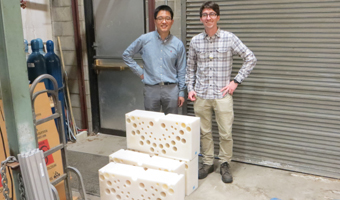The Institute of Nuclear and Particle Physics (INPP) presents Tony Ahn, of Michigan State University, presenting “First Neutron-rich Beam Induced (α,xn) reaction studies with Ha-baNERO,” on Tuesday, September 27, at at 4 p.m. in Edwards Accelerator Lab, Roger W. Finlay Conference Room.

Nuclear physicists Tony Ahn and Zach Meisel stand on the dock at the Edwards Accelerator Lab and behind section of the polyethylene blocks used to slow down neutrons. The holes are where the detectors are placed.
Abstract: Solar abundance pattern tells us historical evidences of element formation in the Universe. While neutron capture process is responsible for elements heavier than iron and the rapid neutron capture process produces the abundance pattern similar to measured one, (α,xn) reactions have been identified as the main production mechanism of Z=38-47 abundances in neutron-rich neutrino winds after core-collapse supernovae. Those conditions entail (n, γ) − (γ, n) equilibrium and temperatures between 3.5 and 5.5 GK in the late phases of the wind. Recent sensitivity studies showed that uncertainties in (α,xn) reaction rates directly affect calculated abundances in the neutrino-driven wind models with an impact that is comparable to that from astrophysical uncertainties. Current reaction rate uncertainties are relatively large since very little experimental data exists for (α,xn) cross sections with neutron-rich nuclei involved in the nucleosynthesis calculation.
We have developed the Heavy ion Accelerated Beam induced (Alpha,Neutron) Emission Ratio Observer (HabaNERO) for the measurement of relevant (α,xn) reactions in the neurtrino-wind including 3He gas-filled proportional tubes oriented in rings along the beam axis embedded in a polyethylene matrix. The configuration of the tubes in the matrix was optimized to obtain a high average neutron detection efficiency as constant as possible in the neutron range En = 0.1-19.5 MeV that corresponds to the neutron energies of interest.
We have performed the detector commissioning using mono-energetic neutron beams at Edward Accelerator Laboratory, Ohio University, as well as a 75Ga(α,xn) cross section measurement at the National Superconducting Cyclotron Laboratory. This experiment was the first measurement of (α,xn) cross section for neutron-rich nuclei in inverse kinematics. The construction, commissioning, and performance of the detector system will be presented. We will also describe how successfully to utilize this system for experiments of (α,xn) reactions using radioactive ion beams.



















Comments